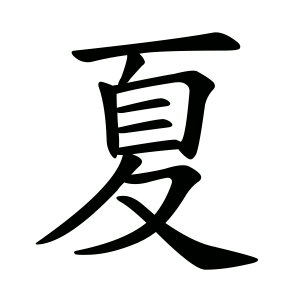夏
- summer;
Also refers to the Xia dynasty (하(夏)나라), and by extension, ancient China or Chinese civilization (화하, 華夏).
Etymology
Complex pictograph / evolved phono-semantic form:
The earliest form of 夏 appears in bronze inscriptions (金文 jinwen) as 夓, showing a figure with a large head (頁) and slowly walking legs (夊).
In some early variants, the head is enclosed by 臼 (절구 구), forming a figure that seems to kneel or bow with hands joined, possibly in a posture of reverence or submission.
Interpretations of the original form include:
A leader (頁) bowing or performing ritual dance (夊 + 臼), symbolizing reverence and order — reflecting the hierarchical spirit of early Chinese civilization.
A person in elaborate ceremonial attire, moving rhythmically — which later metaphorically extended to grandeur, civilization, or brightness.
In clerical script (隸書), the component 臼 disappeared, simplifying the shape to its modern form.
Historical development:
Originally, 夏 denoted the Xia dynasty (하나라) — the legendary first Chinese dynasty, associated with the founder Yu the Great (禹).
Later, by semantic extension and phonetic borrowing, the character came to signify “summer” (the hot season).
In early texts, 夏 was a polyphonic haracter:
When referring to the Xia dynasty or Chinese civilization, it carried a rising tone (上聲).
When meaning summer, it used a departing tone (去聲).
In modern Mandarin, these tones have merged (濁上變去), and all readings are xià (fourth tone).
Usage in Korean
하계 (夏季) — the summer season
하복 (夏服) — summer clothing
하열 (夏熱) — summer heat
화하 (華夏) — China, the cultural homeland of the Chinese people
하왕 (夏王) — a ruler of the Xia dynasty
In modern Korean, 夏 is read 하 and primarily used for the season “summer.”
However, in historical, literary, and cultural contexts, it retains its civilizational meaning (“China,” “the civilized world”) as seen in compounds like 화하 (華夏).
Words that derived from 夏
Additional notes
In oracle bone and bronze inscriptions, 夏 referred not to the season but to the people and state of Xia (하) — the earliest organized polity in Chinese tradition.
Only later, by semantic extension, did it acquire the meaning “summer,” possibly through association with brightness, heat, and abundance.
Some early scholars once claimed that 夏 and 冬 were absent from oracle bone records, implying ancient Chinese lacked those seasonal distinctions.
However, later discoveries confirmed early forms of both, showing that the notion of four seasons existed by the Shang period, though terminology evolved gradually.
In the Book of Documents (書經) and Zuo Zhuan (左傳), 夏 represents both:
「禹敷土,定九州,而天下咸服,號曰夏。」
“Yu spread the land, established the nine provinces, and the world submitted; this was called Xia.”
In such usage, 夏 symbolizes the founding of order and civilization, not merely a temporal season.
Cultural & symbolic notes:
In ancient cosmology, 夏 corresponds to the southern direction, fire element (火), and the color red (赤) — representing growth, warmth, and vitality.
It is also associated with the phoenix (鳳) and the emotion of joy (喜) in the Five Elements theory (五行).
In Confucian symbolism, 夏 marks the time of flourishing virtue and societal harmony — the full bloom of moral order after the “spring” of beginnings.
The term 화하(華夏) later came to mean the refined central civilization, distinguishing the cultivated (夏) from the barbaric (夷) — a concept foundational to ancient Chinese identity.
Symbolic interpretation:
夏 represents the fullness of life and civilization — the height of seasonal, cultural, and moral development.
It stands for heat and vitality, but also for order, centrality, and refinement in the moral universe.
「夏者,盛德之時也。」
“Summer is the time of flourishing virtue.”
Thus, 夏 bridges the natural and the cultural: from the blazing energy of summer to the luminous dignity of civilization itself.
- 一山竹水 (MUHE)
- ⿱ 𦣻 夂 (G J K)
- ⿱ 𦣻 夊 (H T)
